I had a chance to cover Westward Expansion with some of my 8th graders this year - something I haven't been able to do in several years. This meant that I was able to do one of my favorite activities - Angry Tiki-God Water Polo. Okay, not actually. I just haven't come up with a really good name for it yet. Basically, here is what the activity involves though: 1) I download and print several pioneer memoirs and diaries. 2) I break the students up into teams of three and let each team pick which memoir they want to study. 3) The students use highlighters to mark towns and landmarks mentioned in their memoir. 4) The students look up the places on a map. Internet mapping sources are somewhat useful for this, but many of the 19th Century place names can't be found on modern maps, so GoogleMaps isn't foolproof. A better resource has turned out to be the atlas from the 1957 Encyclopedia Britannica. I had already owned one copy of this awesome atlas (for my money, the best one ever printed) and found another at the swap shop at my Town Dump, but I had to order five or six additional copies from eBay. 5) Students then map the pioneers' routes on laminated U.S. maps and describe the voyage. I've got a particularly engaged group of students this year, but I've gotten a lot of buy-in from them and this project seems like a keeper. New Hampshire State Social Studies Frameworks and Standards met by this project:
SS:CV:8:3.2: Analyze environmental, economic, and technological developments and their impact on society. (Themes: C: People, Places and Environment, D: Material Wants and Needs, G: Science, Technology, and Society)SS:GE:8:1.1: Compare relative advantages and disadvantages of using maps, globes, aerial and other photographs, satellite-produced images, and models to solve geographic problems, e.g., the Mercator projections versus Robinson projections. (Themes: C: People, Places and Environment) SS:GE:8:2.3: Describe how culture, technology, and experience affect perception of places and regions, e.g., images created by mass media or travel. (Themes: E: Cultural Development, Interaction, and Change, F: Global Transformation, G: Science, Technology, and Society) SS:GE:8:3.1: Recognize how physical processes influence the formation and distribution of resources, e.g., the potential for hydroelectric power or coal deposits. (Themes: C: People, Places and Environment, G: Science, Technology, and Society) SS:GE:8:4.1: Describe ways in which physical and human regional systems are interconnected, e.g., canal systems or "hub-and-spoke" airline operations. (Themes: C: People, Places and Environment, G: Science, Technology, and Society)Students will be able to find social studies-related information:- Use economic and geographic data, historical sources, as well as other appropriate sources
- Discriminate to select the most worthwhile and trustworthy sources
- Draw on the diversity of social studies-related sources, such as auditory and visual sources, such as documents, charts, pictures, architectural works, and music.
Students will be able to comprehend the wide range of social studies-related materials by using skills:- Distinguish between primary and secondary sources.
- Detect cause and effect relationships
- Distinguish between facts, interpretations, and opinions
- Recognize author bias; recognize propaganda
- Test the validity of information by using such criteria as source, objectivity, technical correctness, currency
- Draw from the source information at a level appropriate to the task at hand, i.e., skimming for facts or probing for deeper meaning
- Utilize various types of sources such as documents, charts, images, artifacts, and maps
Students will be able to find information:- Use appropriate sources to gain meaning of essential terms and vocabulary, glossary, dictionary, texts, word lists
- Recognize and understand relevant social studies terms.
Students will be able to present information in a variety of ways:- Present visually (chart, graph, diagram, model, Power Point, etc.)
- Present orally (presentation, debate, group discussion, simulation, etc.)
I thought I'd share a student's New England mapping quiz.
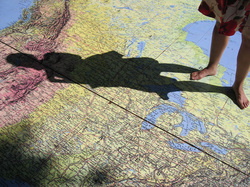 Last weekend, my wife and I finally got a sitter and went to see the final Harry Potter movie. It was an awesome, awesome movie, but my favorite piece of dialog went something like this: "Okay. We're going in.""Just like that? Without a plan?""When have any of our plans ever worked?"Finally - something in Harry Potter that I can truly relate to! I'm unlikely to ever be called on to do anything heroic. I'm so klutzy that if I DID have access to a magic wand, I'd shoot myself in the ear with a laser beam or something. And if I was faced with an angry, evil, noseless villain like Whatz His Face, I'd run screaming into the woods so fast I'd leave a flame trail, blubbering in terror and probably peeing myself. But Harry had a point when he alluded to the perils of over-planning. I've done projects and lessons with my classes over the years that involved weeks or months of planning, which went splendidly. I've also has many which fell apart on contact with real - as opposed to theoretical - students. Whether or not I realize it as I'm planning a lesson, a lot of the time, I'm counting on my students to react in a predictable and logical fashion, which - in real life - they often refuse to do.
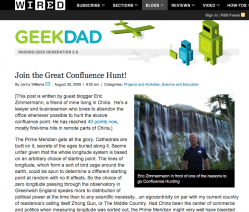 The cool-but-intimidating blog, GeekDad had an intriguing post this morning. Eric Zimmermann, a geography enthusiast living in China, posted about his hobby of documenting "Confluence Points" - the exact point where a whole degree of Latitude and Longitude meet.He points out that a lot of the time, it isn't easy to get to these confluence points; they aren't necessarily near major roads (or even land, for that matter. For the purposes of demonstration, I just looked up Zero Degrees Latitude/Zero Degrees Longitude and found that lies it well off the coast of West Africa.) This makes getting to these points something of an adventure.This got me thinking...
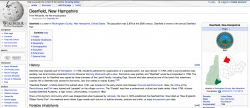 Where is the nearest confluence point in relation to my school?I looked up the town of Deerfield, New Hampshire on GoogleMaps, but discovered to my surprise that it was placed in the White Mountains, several hours' drive from its actual location.Hmmmm...Well, that happens sometimes.So I fell back on my next-most-favorite mapping tool - Wikipedia. I looked up Deerfield, then looked for the link at the right of the page, labeled "Coordinates".
 Clicking this took me to a page called "GeoHack", which told me way, WAY more about Deerfield's latitude and longitude than I had ever wanted to know. Among other useful tools, there were links to take me directly to those coordinates in MapQuest, GoogleEarth and about a dozen other mapping websites. I didn't use any of these links this time, but nodded with satisfaction at how, once again, Wikipedia is much cooler than anyone gives it credit for.I highlighted and copied the coordinates for Deerfield, then plugged them back into GoogleMaps. I removed all the fractions of degrees from the coordinates, which left me with 40 Degrees North Latitude, 71 Degrees West Longitude.I hit Return...
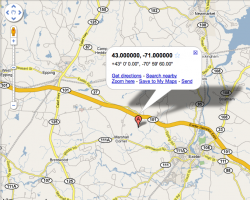 ...and got this.
It turns out that our nearest confluence point is just up the road a little bit - though apparently in somebody's back yard. It wouldn't really be all that hard to zip up there and take a picture of it.
[Admittedly, you could calculate this just as easily with a good map and a ruler, but I was very lazy this morning and didn't want to get off my couch.]
All this leads me to think about what kind of classroom projects I could design out of this.
Here's what I've come up with so far:
1. This is a good way to introduce or reinforce the concepts of Latitude and Longitude. A highly motivated classroom teacher could have his or her students map calculate and map all the confluence points in New Hampshire. (For teachers in bigger states, they could calculate the points around their county.) [Curriculum connections to Math]
2. If the class was studying Map Reading or Orienteering, this could make for a really good field trip - finding and photographing the closest confluence points. [Curriculum connections to Physical Education]
3. The class could design a webpage or blog with an interactive map, showing all the confluence points and providing links to photos the students had taken of them. [Curriculum connections to Literacy and Technology standards]
4. A very motivated class could do some research and find other elementary or middle schools near other, more out-of-reach confluence points and email teachers or students there to take pictures of them and email them back. [Curriculum connections to more Literacy and Technology standards]
The only real question remaining is - am I that motivated?
Time will tell.
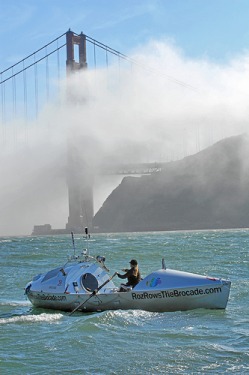 Several months ago, I posted a blog about Roz Savage, an extreme athlete in the process of rowing solo across the Pacific Ocean, the first woman to do so. She finished the first leg of her trip - from San Francisco to Hawaii in January. She's currently gearing up to start the second leg - from Hawaii to Tuvalu at the end of May.
This adventure provides a lot of opportunity to address geography and meteorology in the classroom. With a month to prepare, this might make a good end-of-year attention-grabber.
Please see my earlier blog entry, Roz Savage's blog or her podcast for more information.
So, here's a question you really didn't want to think about:
What is technology?
Okay, if that one's too hard, how about this one:
What is good technology?
That's probably a bit easier to answer.
A good working definition of good technology is probably something like "finding the right tool for a job". Sometimes that involves cables and patches and upgrades, but sometimes it is startlingly simple.
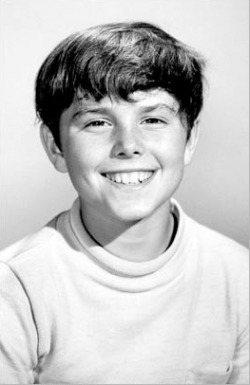 We have a boy in the 8th grade who has been very frustrated in my Social Studies class. Let's call him Peter Brady.
Peter is not a high achiever in most academic areas. He doesn't process information very well and has trouble memorizing things. Each time I give a mapping quiz, he studies really hard and he always THINKS he's done really well, but he often ends up with single digit scores. We've tried modifying his tests, cutting back on the number of places he has to map, giving him a wordbank, etc.., but nothing has helped very much.
About a week ago, one of our classroom aides followed a hunch and cut a bunch of terms out of Peter's wordbank with a pair of scissors and asked him to physically place them on a blank map.
He did it with 90% accuracy within ten seconds.
The Special Ed team and I had a collective AHA! moment so intense it nearly blinded us.
Think about it like this:
Peter needs to look at a landmark on the map, think, "Hmmm, do I know this?", look over at his wordbank, decode the words on the wordbank, pick one, encode it, look at his test sheet, find the number that corresponds with the landmark, decode the term again, and write it down, more or less correctly and legibly.
Of course he was having problems.
By cutting out the wordbank and having him do everything visually/spacially, we tapped a whole different set of skills.
We've taken this concept a step further.
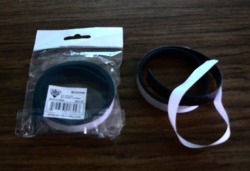 I went to a craft store and bought a few flexible magnetic strips - the kind that they make into the instant poems you find on people's refrigerators. They were in the sale bins at the front of the store for about $1.95 each.
Our Special Ed team used a label-maker to print various terms that I will be using on upcoming mapping quizzes, glued them to a magnetic strip and cut them to length.
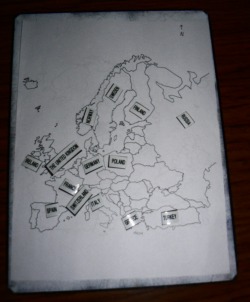 We put a blank map on a mini magnetic whiteboard (though even a cookie sheet would work) and BLAMMO! - we've got an instant, reusable testing setup for visual learners.
We've tested this out on Peter and it works great. Our next step is to try it out on a few other learners with special needs who have consistantly had the same kind of problems.
I feel good. The Special Ed team feels good. Peter feels good. For all I know, the magnets feel good.
Maybe, on the giant teacher spreadsheet in the sky, this balances out those tests I handed back to my students last week without writing the grades in my gradebook. Sigh...
|










 RSS Feed
RSS Feed